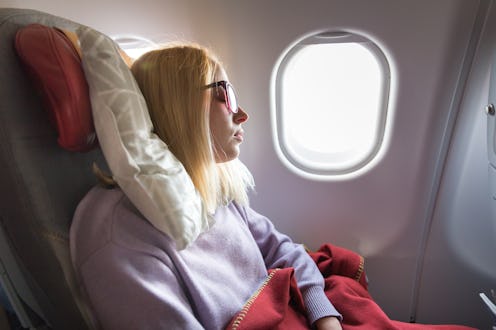Life
What Happens To Your Body When You're On A Long Flight

No matter how many great movies you have lined up, longs flights are generally miserable. Being strapped to an uncomfortable and upright seat, with only stale air to suck on, and a level of air pressure that makes all of your bodily functions more complicated than they should be is some kind of cruel torture. Of course, if a brilliant vacation is on the other end of said long flight, it's easier to endure, but nonetheless, getting there is a drag on not only your mind, but your body, too. If you've ever wondered what happens in your body when you fly long hauls, you've likely experienced that general sense of illness both in-flight and post-flight and your worries are warranted.
If even a short flight will leave you dehydrated, gassy, and fatigued, when you get into those extended hour flights, the effects and complications only increase. According to Theresa Fiorito, MD, an infectious disease specialist at NYU Winthrop Hospital’s Family Travel Clinic, while the air pressure and air quality are definitely large contributors to the way we feel after a long flight, it's actually the lack of mobility that's most dangerous.
"Flight duration reflects the amount of time travelers will be immobile, and some studies show that extended trips may increase the risk for Venous Thromboembolism (blood clots) by a factor of 2:4, especially if additional risk factors are present," Fiorito tells Bustle. Things like smoking, being on oral contraceptive medications, or having a family history of blood clots can increase your chances of this occurring, Fiorito says.
Likewise, being in a confined space for a lengthy period, with other travelers on board who may have contagious illnesses puts you at a greater risk of contracting them. You might think you're safe from someone coughing and sneezing many seats away, but germs are much better at traveling than we might be able to imagine. "Germs can travel as much as 25 feet," Fiorito says, "so if someone sneezes in the aisle at row 10 and doesn’t cover their mouth, someone seated in row 20 might inhale those germs."
If you manage to make it through your flight without contracting the cold or flu or getting a blood clot, the remaining dangers are far more manageable. You can expect to feel tired from a change in your oxygen intake and the interruption to your natural sleep cycle, you can expect to feel dried out and backed up, from being dehydrated and immobile, but all of those issues will fade in the days after your flight and won't have lasting effects.
Whether you have reason to believe you're at a higher risk of getting a blood clot or not, Fiorito suggests all travelers on long flights practice the following:
Move Around
Whenever possible, walk around the plane. If you're permitted to, stand, stretch your legs and get your blood flowing. If you can't get up from your seat, Fiorito suggest doing calf exercises in your seat. Moving and massaging your legs regularly will help to keep your blood moving.
Drink A Lot Of Water
Maintain adequate hydration, even if that means you have to get up to use the bathroom more than you'd like. The more water you drink, the less backed up you'll be and the less discomfort you'll feel in your gut.
Avoid Restrictive Clothing
Wear loose pants and forget the belt. Make sure that none of your clothing is cutting off your circulation or making it hard for your blood to move freely.
Wear Compression Stockings
Compression stockings are suggested for those with increased risks of blood clots or a history of leg swelling, but can be worn by all. Tall socks will keep your feet warm and your blood moving.
Expert:
Theresa Fiorito, MD, infectious disease specialist at NYU Winthrop Hospital’s Family Travel Clinic
This article was originally published on